The Monetary Convention of 23 December 1865 was a unified system of coinage that provided a degree of monetary integration among several European countries, initially Belgium, France, Italy and Switzerland, at a time when the circulation of banknotes in these countries remained relatively marginal. In early 1866, it started being referred to in the British press as the Latin Monetary Union, with intent to make clear that the United Kingdom would not join, and has been generally referred to under that name (French: union latine) and the acronym LMU since then. A number of countries minted coins according to the LMU standard even though they did not formally join the LMU.
The LMU has been viewed as a forerunner of late-20th-century European monetary union but cannot be directly compared with it, not least since the LMU did not rely on any common institutions. Unlike the Scandinavian Monetary Union established a few years later, the Latin Monetary Union remained limited to coinage and never extended to paper money. That made the LMU increasingly less relevant, and it was quietly disbanded in 1926.
History

Preliminary context
The LMU adopted the specifications of the French gold franc, which had been introduced by Napoleon I in 1803 and was struck in denominations of 5, 10, 20, 40, 50 and 100 francs, with the 20 franc coin (6.45161 grams or 99.5636 grains of .900 fine gold struck on a 21-millimetre or 0.83-inch planchet) being the most common. In the French system the gold franc was interchangeable with the silver franc based on an exchange ratio of 1:15.5, which was the approximate relative value of the two metals at the time of the law of 1803.
Initial treaty
| Denomination | Composition | Mass | Diameter |
|---|---|---|---|
| 1 centime | Bronze | 1 g | 15 mm |
| 2 centimes | Bronze | 2 g | 20.2 mm |
| 5 centimes | Bronze | 5 g | 25 mm |
| 10 centimes | Bronze | 10 g | 30 mm |
| 20 centimes | Silver (.835) | 1 g | 16 mm |
| 50 centimes | Silver (.835) | 2.5 g | 18 mm |
| 1 franc | Silver (.835) | 5 g | 23 mm |
| 2 francs | Silver (.835) | 10 g | 27 mm |
| 5 francs | Silver (.900) | 25 g | 37 mm |
| 10 francs | Gold (.900) | 3.2258 g | 19 mm |
| 20 francs | Gold (.900) | 6.45161 g | 21 mm |
| 50 francs | Gold (.900) | 16.12903 g | 28 mm |
| 100 francs | Gold (.900) | 32.25806 g | 35 mm |
By treaty dated 23 December 1865, France, Belgium, Italy, and Switzerland formed the Latin Monetary Union. They agreed to a combined gold and silver standard (bimetallism) with a gold-to-silver ratio of 15.5 to 1 as established in the French Franc. One LMU Franc represented 4.5 grams (69 grains) of fine silver or 0.290322 grams (4.48035 grains) of fine gold.
The treaty required that all four contracting states strike freely exchangeable gold coins and silver coins according to common specifications. Before the treaty, for example, the fineness of the silver coins in the four states varied from 0.800 to 0.900. The treaty required that the largest silver coin of 5 francs be struck 0.900 fine and the fractional silver of 2 francs, 1 franc, 50 centimes and 20 centimes all be struck at 0.835 fine. The agreement came into force on 1 August 1866.
The LMU served the function of facilitating trade between different countries by setting the standards by which gold and silver currency could be minted and exchanged. In this manner a French trader could accept Italian lire for his goods with confidence that it could be converted back to a comparable amount of francs.
Further joining members
Following the International Monetary Conference of 1867, the original four nations were joined by Greece on April 10, 1867. Greece took advantage of a clause in the treaty that guaranteed admission of foreign states that agreed to abide by the treaty. Spain and Romania also considered joining. The discussions broke off unsuccessfully, but both countries nevertheless made an attempt to conform their currencies to the LMU standard. Austria-Hungary refused to join the LMU because it rejected bimetallism, but signed a separate monetary treaty with France on December 24, 1867 whereby both states agreed to receive into their treasuries one another's gold coins at specified rates. Austria-Hungary thereafter minted some but not all of its gold coins on the LMU standard, including the 4 and 8 florin, which matched the specifications of the French 10 and 20 francs.
Other states later adopted the system without formally joining the treaty: The colonies of France (including Algeria) came under the scope of the treaty in 1865; Peru adopted the franc system by law on July 31, 1863; Colombia and Venezuela followed in 1871; the Grand Duchy of Finland adopted the system on August 9, 1877; Serbia on November 11, 1878; and Bulgaria on May 17, 1880. Coins struck for the Spanish territory of Puerto Rico in 1895 adhered to the standard, with one peso to five Spanish pesetas. In 1904, the Danish West Indies were also placed on this standard but did not join the Union itself. When Albania emerged from the Ottoman Empire as an independent nation in 1912, coins of the Latin Monetary Union from France, Italy, Greece, and Austria-Hungary began to circulate in place of the Ottoman Lira. Albania did not however mint its own coins, or issue its own paper money until it adopted an independent monetary system in 1925.
With the tacit agreement of Napoleon III of France, Giacomo Antonelli, the administrator of the Papal Treasury, embarked from 1866 on an ambitious increase in silver coinage without the prescribed amount of precious metal, equivalent to Belgium's total. The papal coins quickly became debased and excessively circulated in other union states, to the profit of the Holy See, but Swiss and French banks rejected papal coins and the Papal States were ejected from the Union in 1870, owing 20 million lire.
Issues

| This section needs additional citations for verification. Please help improve this article by adding citations to reliable sources in this section. Unsourced material may be challenged and removed. Find sources: "Latin Monetary Union" – news · newspapers · books · scholar · JSTOR (October 2022) (Learn how and when to remove this message) |
Bimetallism failure
From the beginning, fluctuations in the relative value of gold and silver on the world market stressed the currency union. This is today recognized as an inevitable effect of a currency based on bimetallism when precious metal prices fluctuate. When the LMU was formed in 1865, silver was nearing the end of a period of high valuation compared to gold. In 1873 the value of silver dropped significantly, followed by a sharp increase in silver imports in the LMU countries, particularly in France and Belgium. By 1873, the decreasing value of silver made it profitable to mint silver in exchange for gold at the Union's standard rate of 15.5 : 1. Indeed, in all of 1871 and 1872 the French mint had received just 5,000,000 francs of silver for conversion to coin, but in 1873 alone received 154,000,000 francs. Fearing an influx of silver coinage, the member nations of the Union agreed in Paris on January 30, 1874, to limit the free conversion of silver temporarily. By 1878, with no recovery in the silver price in sight, minting of silver coinage was suspended absolutely. From 1873 onwards, the Union was on a de facto gold standard. The law still permitted payment in silver, but custom demanded and enforced payment in gold. The 5 franc silver pieces were "essentially upon the same footing as bank notes".
More importantly, because new discoveries and better refining techniques increased the supply of silver, the fixed LMU exchange rate eventually overvalued silver relative to gold. German traders, in particular, were known to bring silver to LMU countries, have it minted into coinage then exchanged those for gold coins at the discounted exchange rate. These destabilizing tactics eventually forced the LMU to convert to a pure gold standard for its currency in 1878.
Debasement of the coinage
Some members began to debase their currency. and then exchanged them for coins from other countries that had been minted correctly, thus in effect forcing other members of the Union to do the same. According to the BBC, Greece with its "chronically weak economy meant successive Greek governments responded by decreasing the amount of gold in their coins, thereby debasing their currency in relation to those of other nations in the union and in violation of the original agreement". Greece was formally expelled from the Latin Monetary Union in 1908. It was readmitted in 1910, however.
Paper money issues
According to the Financial Times, another major problem of the LMU was that it failed to outlaw the printing of paper money based on the bimetallic currency. France and Italy exploited this weakness by printing banknotes to fund their own endeavours, effectively "forcing other members of the union to bear some of the cost of its fiscal extravagance by issuing notes backed by their currency".
Effect of the Great War
In 1922 Latvian lat and in 1924 Polish złoty adopted LMU standard.
The political turbulence of the early twentieth century which culminated in the First World War brought the Latin Monetary Union to its final end in practice, even though it continued de jure until 1927, when it came to a formal end.
The last coins made according to the standards (i.e., diameter, weight and silver fineness) of the Union were the Swiss half, one-franc, and two-franc pieces of 1967. However, Austria still mints gold 4 and 8 florin gold coins to the LMU specifications for collectors and investors, and modern gold rounds to LMU standards are also commercially minted.
Impact
A 2018 study in the European Review of Economic History found that the LMU had no significant effects on trade, except during the period 1865–1874.
The Latin Monetary Union inspired the Scandinavian Monetary Union, established in 1873.
Coins
Below are examples of coins of 5 units silver coins:
| 5 Greek drachmae 1876 | |
|---|---|
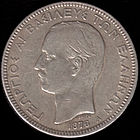 
| |
| George I of Greece | Coat of arms of Greece |
| 5 Belgian francs 1868 | |
|---|---|
 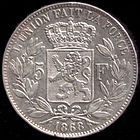
| |
| Leopold II of Belgium | Coat of arms of Belgium |
| 5 French francs 1868 | |
|---|---|
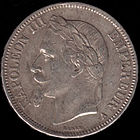 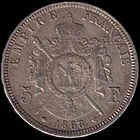
| |
| Napoleon III of France | Coat of arms of the Second Empire |
| 5 Italian lire 1874 | |
|---|---|
 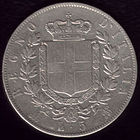
| |
| Victor Emmanuel II of Italy | Coat of arms of the House of Savoy |
| 5 Spanish pesetas 1885 | |
|---|---|
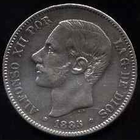 
| |
| Alfonso XII of Spain | Coat of arms of Spain |
| 5 Venezuelan bolívares 1912 | |
|---|---|
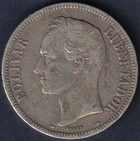 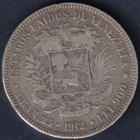
| |
| Simón Bolívar | Coat of arms of Venezuela |
| 5 Swiss Francs 1889 | |
|---|---|

| |
| Coat of arms of Switzerland | Libertas |
| 5 Romanian lei 1883 | |
|---|---|

| |
| Carol I of Romania | Coat of arms of Romania |
See also
- Bimetallism
- Economic and Monetary Union of the European Union
- Euro
- Latin Union
- Spanish peseta
- Stella (United States coin)
- Vreneli
Notes
- Not borne out by references in coin catalogues, e.g. Krause & Mishler, Standard Catalog of World Coins, 19th century, which shows LMU standard finenesses for Papal States silver and gold coinage with no debasement.
- This assertion is not supported by the coinage record. Greece issued no silver or gold coins for circulation after 1884 (silver resumed in 1910), and all extant coins from the period in question (prior to 1884 and in 1910/11) are of LMU standard.
- The cupro-nickel 1⁄2, 1 and 2-franc coins made since 1968 were also still of LMU-standard weight and diameter, though no longer silver.
References
- ^ Einaudi, Luca (September 2018). "A Historical Perspective on the Euro: the Latin Monetary Union (1865–1926)" (PDF). Ifo DICE Report. 16 (3).
- Willis, Henry Parker (1901). A History of the Latin Monetary Union: A Study in International Monetary Action. Chicago: University of Chicago Press. p. 1. Retrieved 12 June 2018 – via Internet Archive.
- "Search the coin catalogue – Numista". en.numista.com. Retrieved 2023-03-12.
- ^ Recueil des traités de la France (1864-1867) [Collection of the treaties of France (1864-1867)]. Vol. 9. pp. 453–458. Archived from the original on 2020-11-22. Retrieved 2007-09-30.
- ^ Pollard, John F. (2005). Money and the Rise of the Modern Papacy: Financing the Vatican, 1850–1950. New York: Cambridge University Press. p. 39. ISBN 978-0-521-81204-7. Archived from the original on 2023-01-15. Retrieved 2020-11-15 – via Google Books.
- ^ Willis, Henry Parker (1901). A History of the Latin Monetary Union: A Study in International Monetary Action. Chicago: University of Chicago Press. p. 81 – via Internet Archive.
- Willis, Henry Parker (1901). A History of the Latin Monetary Union: A Study in International Monetary Action. Chicago: University of Chicago Press. p. 83 – via Internet Archive.
- Willis, Henry Parker (1901). A History of the Latin Monetary Union: A Study in International Monetary Action. Chicago: University of Chicago Press. p. 84 – via Internet Archive.
- Yeoman, R. S. (2022). Jeff Garrett; Kenneth E. Bressett; Q. David Bowers (eds.). A guide book of United States coins. Mega red (8th ed.). Pelham, AL: Whitman Publishing. pp. 1318–1319. ISBN 978-0-7948-4966-5. OCLC 1350926401.
- "Daggar Jon's 'Coin and Currency'". Archived from the original on 2015-01-20. Retrieved 2009-11-11.
- Einaudi, Luca (2001). European Monetary Unification and the International Gold Standard (1865–1873). Oxford University Press. p. 104. ISBN 978-0-19-924366-2.
- Willis, Henry Parker (1901). A History of the Latin Monetary Union: A Study in International Monetary Action. Chicago: University of Chicago Press. pp. 85–86 – via Internet Archive.
- Willis, Henry Parker (1901). A History of the Latin Monetary Union: A Study in International Monetary Action. Chicago: University of Chicago Press. p. 116 – via Internet Archive.
- Laughlin, James Laurence (1898). "Chapter XI". The History of Bimetallism in the United States (PDF). D. Appleton and Co. ISBN 978-1-297-44892-8. Archived (PDF) from the original on 2022-01-20. Retrieved 2020-11-21.
- Willis, Henry Parker (1901). A History of the Latin Monetary Union: A Study in International Monetary Action. Chicago: University of Chicago Press. p. 266 – via Internet Archive.
- "The Latin Monetary Union". goldcoin.org. Archived from the original on 4 March 2014. Retrieved 2 February 2012.
- "5: Enthusiasm and Resistance to Union in Britain and Germany". European Monetary Unification and the International Gold Standard (1865-1873) (PDF). Oxford University Press. 2001. Archived from the original (PDF) on 8 August 2007.
- Krause & Mishler, Standard Catalog of World Coins, 19th-century & 20th-century volumes (annual publications)
- ^ "A Point of View: Making friends the shared currency way". BBC News. 2 March 2012. Archived from the original on 19 December 2018. Retrieved 26 February 2012.
- "Eurozone: A nightmare scenario - Latin Lessons". Financial Times. 16 September 2011. Archived from the original on 2022-12-10.
- Jaskólski, Józef (1924). Tabele walutowe i towarowe 1914-1924. Lwów: Spółki Akcyjnej Wydawniczej.
- Krause & Mishler, Standard Catalog of World Coins, 20th century.
- "Buy Swiss Gold from Echtgeld AG". www.echtgeld.ch. Archived from the original on 28 August 2016. Retrieved 27 August 2016.
- Timini, Jacopo (2018). "Currency unions and heterogeneous trade effects: the case of the Latin Monetary Union" (PDF). European Review of Economic History. 22 (3): 322–348. doi:10.1093/ereh/hex027.
Further reading
- Bae, Kee-Hong; Bailey, Warren (2011). "The Latin Monetary Union: Some Evidence on Europe's Failed Common Currency". Review of Development Finance. 1 (2): 131–149. doi:10.1016/j.rdf.2011.03.001.
- Flandreau, Marc (2000). "The Economics and Politics of Monetary Unions: A Reassessment of the Latin Monetary Union, 1865–71". Financial History Review. 7 (1): 25–44. doi:10.1017/s0968565000000020. S2CID 154714928.
- Redish, Angela (1993). "The Latin Monetary Union and the Emergence of the International Gold Standard". In Bordo, Michael D.; Capie, Forrest (eds.). Monetary Regimes in Transition. New York: Cambridge University Press. pp. 68–85. ISBN 978-0-521-41906-2.
- Nenovsky, Nikolay; Jacques-Marie, Vaslin (2020). "Shadowing the Latin Monetary Union: Monetary regimes and interest rates in the Balkan periphery (1867-1912)". The Journal of European Economic History. 49 (2): 71–114. ISSN 2499-8281.
External links
- Grand-dad of today's Euro: The Latin Monetary Union (1865-1927)
- Coins of the Latin Monetary Union: 1865 - 1926
- Economic history of France
- Economic history of Greece
- Economic history of the Holy See
- Economic history of Italy
- Economic history of Romania
- Economic history of Serbia
- Economic history of Spain
- Economic history of Switzerland
- 19th century in economic history
- Metallism
- Currency unions
- Numismatics
- Economic history of Belgium